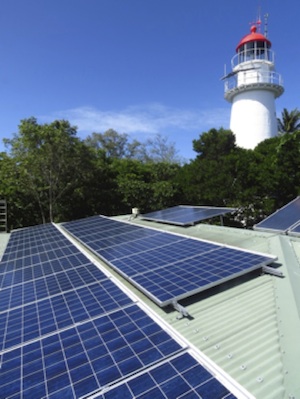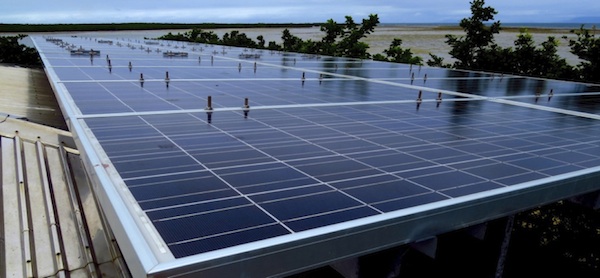An island powered by the Sun
Low Isles is a coral cay located 15 km off Port Douglas on the northern Queensland coast and is within the Great Barrier Reef World Heritage Area. The Low Isles is surrounded by Marine National Park Zone (IUCN Category II).
Low Island is a Commonwealth Islands Zone within the Great Barrier Reef Marine Park and is held on behalf of the Commonwealth of Australia by the Great Barrier Reef Marine Park Authority. The island is jointly managed by the Authority and the Queensland Parks and Wildlife Service. It is a high visitation area where on a busy day there are typically between 200-300 visitors, and in the low season about 100.
In 2012 Low Isles became the first island in the Great Barrier Reef World Heritage Area to be powered exclusively by renewable energy.
Off Grid Stand Alone Solar Power Station
The total energy requirements of the island’s infrastructure are at present supplied by the renewable energy system, providing a carbon neutral environment.
The case of Low Isles shows a continuous improvement process towards 100% renewable energy. In 1963, diesel generation was introduced to provide 240 volt mains power supply to the island’s infrastructure and lighthouse. During 1998, a hybrid power station was constructed consisting of a solar array, inverter and battery bank. These were designed to operate in conjunction with the diesel generator to provide continuous power to the islands residences 24 hours a day. Finally, in 2013, the renewable energy system was once again upgraded introducing state of the art equipment with a commitment to ensure that the islands operations remain carbon neutral well into the future.
The renewable energy system implemented is relatively simple. There are two solar arrays with 80m2 active solar surface area, providing 11 kW peak power. One array is mounted on a free standing structure tilted 5 degrees to the South for maximum yield during the summer months. The second array is roof mounted on a 15 degree tilt to the North for optimal yield during the winter months. The system uses an inverter with a comprehensive data logging system, directly monitored via a computer system, and relies on a battery bank (60 cells configured to provide a 120 volt system with a 700 ampere-hour capacity).
Energy Management Plan
Low Isles has an Energy Management Plan that was implemented in 2012 which resulted in a 40% reduction in energy use for the island operations.
The Energy Management Plan covers the proper operation of such systems as wastewater treatment, water pumping and supply, and includes a detailed catalogue of energy saving initiatives. Since the implementation of the Energy Management Plan, the greatest energy use on the island is powering refrigeration in each residence, and the Wastewater Treatment Plant.
The island power usage is monitored consistently and recorded four to five times a day, to ensure that the operations are within specified guidelines.If excessive energy is being used, an investigation is undertaken to find the source of the unscheduled energy use.
Lessons learned and replicability
The experience at Low Isles shows the importance of continuous monitoring of renewable energy based solutions, and especially the importance of energy efficiency and saving plans in such circumstances.
This showcases a commitment to a carbon neutral policy well into the next decade, providing a model of environmental sustainability within the Great Barrier Reef World Heritage Area.
Low Isles’ solution and management model can serve as a reference for a large number of small isolated areas in UNESCO sites that are visited for tourism or research-related activities.
© Great Barrier Reef Marine Park Authority. Solar array 30 x 170W PV modules.


















